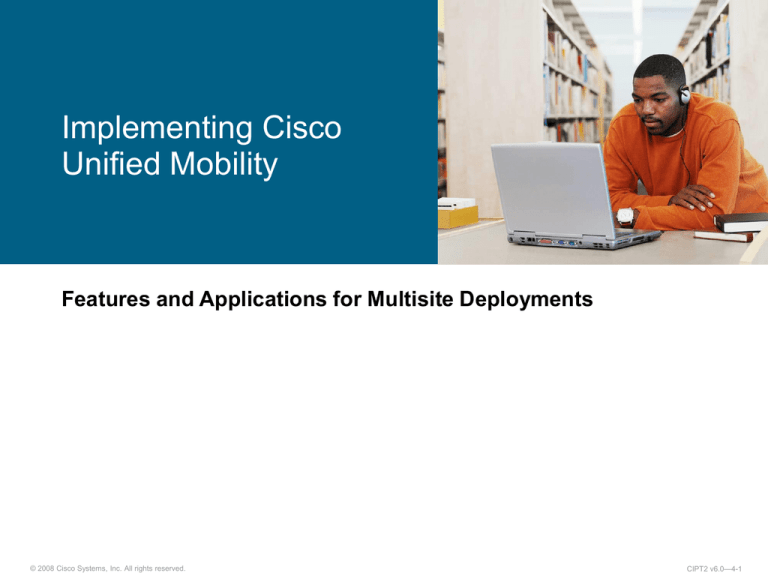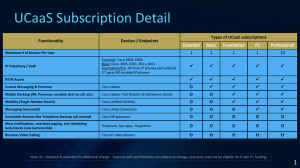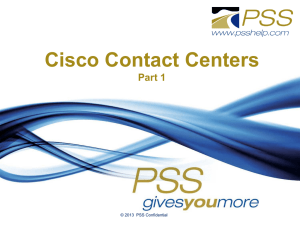
Implementing Cisco
Unified Mobility
Features and Applications for Multisite Deployments
© 2008 Cisco Systems, Inc. All rights reserved.
CIPT2 v6.0—4-1
Outline
Cisco Unified Mobility Overview
Cisco Unified Mobility Call Flow
Cisco Unified Mobility Components
Cisco Unified Mobility Configuration
© 2008 Cisco Systems, Inc. All rights reserved.
CIPT2 v6.0—4-2
Cisco Unified Mobility Overview
© 2008 Cisco Systems, Inc. All rights reserved.
CIPT2 v6.0—4-3
Cisco Unified Mobility
Customer
Cisco Unified
Communications
Manager
Call to office
number.
Call to Mobile
Voice Access
directory
number.
Mobile Voice Access
establishes a system
to create enterprise
calls from any
location.
PSTN
Gateway
Remote
Phone
Office Phone
Mobile Connect lets
remote and office
phones ring
simultaneously.
Cisco Unified Mobility has two components: Mobile Connect and Mobile Voice
Access (MVA).
With Mobile Connect, calls placed to office phones ring the office phones and
associated remote phone.
MVA allows users to call into the enterprise from any phone and place outgoing
calls that appear to come from their office phone.
© 2008 Cisco Systems, Inc. All rights reserved.
CIPT2 v6.0—4-4
Mobile Connect and MVA Characteristics
Mobile Connect characteristics:
Receive calls on multiple devices by using a single phone number
Answer incoming calls on office or remote phone
Switch active calls between office and remote phone
MVA characteristics:
Originate enterprise calls from any remote destination by:
– Dialing to the enterprise MVA number
– Entering ID (if required) and PIN
– Entering destination number to be called
Called party sees the office phone number as the calling party
Switch active calls between office and remote phone
© 2008 Cisco Systems, Inc. All rights reserved.
CIPT2 v6.0—4-5
Cisco Unified Mobility Features
Single (office) number for multiple devices:
– Enterprise caller ID preservation
– Single enterprise voice mailbox
User-configurable access lists to permit or deny calling numbers
that can ring a specific remote phone
User interface to enable or disable Cisco Unified Mobility:
– Mobile Voice Access TUI
– Cisco Unified Communications Manager user webpages
Access to enterprise features from remote phones using DTMF:
– Softkeys can be used on phones with smart client installed.
Call logging (CDR)
© 2008 Cisco Systems, Inc. All rights reserved.
CIPT2 v6.0—4-6
Cisco Unified Mobility Call Flow
© 2008 Cisco Systems, Inc. All rights reserved.
CIPT2 v6.0—4-7
Mobile Connect Call Flow—Incoming
Calls to Office Phone
Cisco Unified
Communications
Manager
Outside Caller
Gateway
479-5551555
511-5552XXX
Call to
1-511-555-2001
Mobile Connect
PSTN
Caller ID:
479-555-1555
Office Phone
2001
408-555-1001
Remote Phone
of 2001
Outside caller calls office phone 2001 (dials 1-511-555-2001).
Mobile Connect rings office phone and remote phone.
Call is picked up at remote phone; caller ID of outside caller is
preserved at remote phone.
© 2008 Cisco Systems, Inc. All rights reserved.
CIPT2 v6.0—4-8
Mobile Connect Call Flow—Internal Calls
Placed from Remote Phone
Cisco Unified
Communications
Manager
Gateway
511-5552XXX
Caller ID:
2001
Mobile Connect
Office Phone
2001
PSTN
Call to
1-511-555-2002
408-555-1001
2002
Remote
Phone of 2001
Remote phone calls internal phone 2002 (dials 1-511-555-2002).
Mobile Connect replaces caller ID (408-555-1001) of remote
phone with directory number of associated office phone (2001).
© 2008 Cisco Systems, Inc. All rights reserved.
CIPT2 v6.0—4-9
MVA Call Flow
Cisco Unified
Communications
Manager
VoiceXML—
Enter ID And
PIN
Outside
Destination
Gateway IVR
Application
2999
511-5552XXX
479-5551555
Caller ID:
511-555-2001
MVA
VoiceXML
PSTN
Call to
1-511-555-2999
Office Phone 2001
408-555-1001
Remote
Phone of 2001
Remote phone dials MVA number (1-511-555-2999).
Caller is authenticated at Cisco Unified Communications Manager and
requests call to outside destination 9-1-479-555-1555.
Caller is connected to MVA media resource from where the outgoing call
is placed on behalf of the office phone (2001).
© 2008 Cisco Systems, Inc. All rights reserved.
CIPT2 v6.0—4-10
Cisco Unified Mobility
Components
© 2008 Cisco Systems, Inc. All rights reserved.
CIPT2 v6.0—4-11
Cisco Unified Mobility Requirements
Cisco Unified Mobility requires:
Cisco Unified Communications Manager 6.0
Cisco Unified Mobile Voice Access service activated
H.323 or SIP gateway providing Mobile Voice Access IVR
application
Out-of-band DTMF
Remote Destinations must be external devices
© 2008 Cisco Systems, Inc. All rights reserved.
CIPT2 v6.0—4-12
Cisco Unified Mobility Configuration Elements
Configuration
Element
Name
Configuration Element
Function
End User
The end user is referenced by the office phone and remote destination
profile. Mobile Connect and/or MVA must be enabled.
A maximum number of remote destinations can be configured.
Phone
The office phone needs to be configured with an owner (i.e., the end user).
Remote
Destination
Profile
A virtual phone device. Per office phone number, a shared line is
configured. End user, (device) CSSs, and MOH audio sources are
specified. One or more remote destinations are added.
Remote
Destination
Associated with shared line(s) of remote destination profile. Configured
with destination number. Optionally, access lists can be applied. Mobile
Phone and Mobile Connect functions are selectively enabled.
Access List
Filters used to permit or deny incoming calls placed to the office phone
to ring a remote destination. Permitted or denied caller IDs are specified.
MVA Media
Resource
Media resource used to interact with the VoiceXML call application running
on a Cisco IOS router. Only required for MVA.
© 2008 Cisco Systems, Inc. All rights reserved.
CIPT2 v6.0—4-13
Shared Line Between Phone and Remote
Destination Profile
Line1: 2001
Partition
CSS
etc.
Office Phone 1
MAC Address
Owner
CSS
etc.
Line1: 2002
Partition
CSS
etc.
shared line
Call to shared line
rings office phone
line and remote
destination(s)
associated with
corresponding
line of remote
destination profile.
© 2008 Cisco Systems, Inc. All rights reserved.
Office Phone 2
MAC Address
Owner
CSS
etc.
shared line
Remote
Destination1:
9-1-408-5551001
Line1: 2001
Partition
CSS
etc.
Remote
Destination2:
9-1-479-5551555
Line2: 2002
Partition
CSS
etc.
Remote
Destination
Profile
User ID
CSS
Rerouting CSS
etc.
CIPT2 v6.0—4-14
Relationship of Cisco Unified Mobility
Configuration Elements
Service Activation
Softkeys
MVA Service
Mobility Softkey
Owner
Service Parameter
Enable MVA, Enterprise Feature Access
Owner
Media Resources
MVA Number, Localization
IVR Application
VoiceXML
Call MVA
Enter RD and PIN
PIN
User
Enable Mobility
Enable MVA
RD Limit
IP phone
ACL
User ID
RDP
RD1
Enable MC
H.323 Gateway
RD2
Enable MC
ACL: Access List, MC: Mobile Connect, MVA: Mobility Voice Access, RD: Remote Destination, RDP: Remote Destination Profile
© 2008 Cisco Systems, Inc. All rights reserved.
CIPT2 v6.0—4-15
Cisco Unified Mobility Configuration
© 2008 Cisco Systems, Inc. All rights reserved.
CIPT2 v6.0—4-16
Cisco Unified Mobility—Mobile Connect
Configuration Procedure
Configure Mobile Connect:
1. Add mobility softkey to IP phone softkey templates.
2. Configure end user.
3. Configure IP phone.
4. Configure remote destination profile with shared line.
5. Configure remote destination(s) to remote destination profile.
6. Configure service parameters.
7. Optional: Implement access lists to specify which caller ID is allowed
to ring a remote destination when a call to the office phone is received.
a) Configure access lists.
b) Apply access lists to remote destination.
© 2008 Cisco Systems, Inc. All rights reserved.
CIPT2 v6.0—4-17
Step 1: Configure Softkey Template
Device > Device Settings > Softkey Template
Add the Mobility softkey
to On Hook and to
Connected call state.
© 2008 Cisco Systems, Inc. All rights reserved.
CIPT2 v6.0—4-18
Step 2: Configure End User
User Management > End User
Enable Mobile Connect
for end user.
Set maximum
number of remote
destinations for end
user.
© 2008 Cisco Systems, Inc. All rights reserved.
CIPT2 v6.0—4-19
Step 3: Configure IP Phone
Device > Phone
This line will be
shared with remote
destination profile.
Assign softkey
template.
Set Owner User ID.
© 2008 Cisco Systems, Inc. All rights reserved.
CIPT2 v6.0—4-20
Step 4: Configure Remote Destination Profile
Device > Device Settings > Remote Destination Profile
Click here and
add line of office
phone. After add,
screen updates.
CSS used for
outgoing calls
placed using
MVA.
CSS used for
ringing remote
destination(s) when
receiving a call at
the office phone.
Note: Line is shared with office phone. Configured line CSS and partition
apply to both devices: office phone and remote destination profile. Line CSS
and device CSS are combined (partitions of line CSS considered first).
© 2008 Cisco Systems, Inc. All rights reserved.
CIPT2 v6.0—4-21
Step 5: Add Remote Destination(s) to Remote
Destination Profile
Device > Remote Destination
Number of remote
destination.
Line(s) of remote
destination profile
are shown only
after setting remote
destination profile
and clicking Save.
Once saved,
remote destination
profile cannot be
changed.
© 2008 Cisco Systems, Inc. All rights reserved.
Allows transfers of active
calls from office phone to
remote destination using
the Mobility softkey.
Associate remote
destination with
line(s) of remote
destination profile.
Allows calls placed to
office phones to also ring
the remote destination.
CIPT2 v6.0—4-22
Step 6: Configure Service Parameters
System > Service Parameters
If configured remote
destination number does not
match caller ID of remote
phone (e.g., because of 9-1
prefix in remote destination
number), change from
Complete Match to Partial
Match and set the number
of digits that have to match.
Otherwise, calls to internal
devices are not shown with
caller ID of office phone.
© 2008 Cisco Systems, Inc. All rights reserved.
CIPT2 v6.0—4-23
Step 7a: Configure Access List
Device > Device Settings > Access List
Enter name and description
and select owner.
Select type of ACL: Allowed
(if checked) or Blocked (if
unchecked)
Click Add Member for initial
configuration of an access list
member.
Click entry from list at bottom
to change configuration of
existing member.
© 2008 Cisco Systems, Inc. All rights reserved.
CIPT2 v6.0—4-24
Step 7b: Apply Access List to Remote
Destination
Device > Remote Destination
Either allowed or
blocked acess list can
be set. If blocked
access list is set, all
numbers not listed in
access list are allowed
(and vice versa).
© 2008 Cisco Systems, Inc. All rights reserved.
CIPT2 v6.0—4-25
Cisco Unified Mobility—Mobile Voice
Access Configuration Procedure
Configure MVA:
1. Activate Cisco Unified Mobile Voice Access Service.
2. Configure service parameters:
a) Enable MVA globally.
b) Enable and configure enterprise feature access.
3. Enable MVA per end user.
4. Configure MVA media resource.
5. Configure MVA VoiceXML application at Cisco IOS gateway.
© 2008 Cisco Systems, Inc. All rights reserved.
CIPT2 v6.0—4-26
Step 1: Activate Cisco Unified Mobile
Voice Access Service
Cisco Unified Serviceability > Tools Service Activation
© 2008 Cisco Systems, Inc. All rights reserved.
CIPT2 v6.0—4-27
Step 2: Configure Service Parameters
System > Service Parameters
View default
enterprise feature
codes and change if
required.
Enable access to
enterprise features.
Enable MVA globally.
© 2008 Cisco Systems, Inc. All rights reserved.
CIPT2 v6.0—4-28
Step 3: Enable MVA per End User
User Management > End User
Enable MVA for end user.
© 2008 Cisco Systems, Inc. All rights reserved.
CIPT2 v6.0—4-29
Step 4: Configure MVA Media Resource
Media Resources > Mobile Voice Access
Enter number of
MVA media
resource.
The H.323 gateway running
the MVA call application needs
to have access to the partition
of the MVA number (if set).
At least one locale has to be
selected for the MVA media
resource.
© 2008 Cisco Systems, Inc. All rights reserved.
CIPT2 v6.0—4-30
Step 5: Configure MVA at Cisco IOS
Gateway
application
service mva http://10.1.1.1:8080/ccmivr/pages/IVRMainpage.vxml
!
voice-port 0/0/0:23
translation-profile incoming pstn-in
!
voice translation-profile pstn-in
translate called 1
!
voice translation-rule 1
rule 1 /.*5552\(...$\)/ /2\1/
dial-peer voice 1 pots
!
destination-pattern 9T
dial-peer voice 29991 pots
incoming called-number 2...
service mva
direct-inward-dial
incoming called-number 2999
port 0/0/0:23
direct-inward-dial
!
!
dial-peer voice 2 voip
dial-peer voice 29992 voip
destination-pattern 2...
destination-pattern 2999
session target ipv4:10.1.1.1
session target ipv4:10.1.1.1
incoming called-number 9T
dtmf-relay h245-alphanumeric
codec g771ulaw
codec g711ulaw
no vad
© 2008 Cisco Systems, Inc. All rights reserved.
CIPT2 v6.0—4-31
Summary
Mobile Connect enables users to receive calls placed to their enterprise
number at the enterprise phone and remote phones such as cell phones.
Mobile Voice Access extends the Mobile Connect functionality by
allowing enterprise calls placed from a remote phone to first connect to
the enterprise and then break back out to the called number using the
enterprise number of the user as the calling number.
Mobile Voice Access requires an H.323 gateway providing an IVR
application to Mobile Voice Access users.
The Cisco Unified Mobile Voice Access service must be activated in the
Cisco Unified Communications Manager cluster for Mobile Voice Access.
Implementation of Cisco Unified Mobility includes the configuration of
access lists, remote destination profile, and remote destinations.
© 2008 Cisco Systems, Inc. All rights reserved.
CIPT2 v6.0—4-32
© 2008 Cisco Systems, Inc. All rights reserved.
CIPT2 v6.0—4-33









